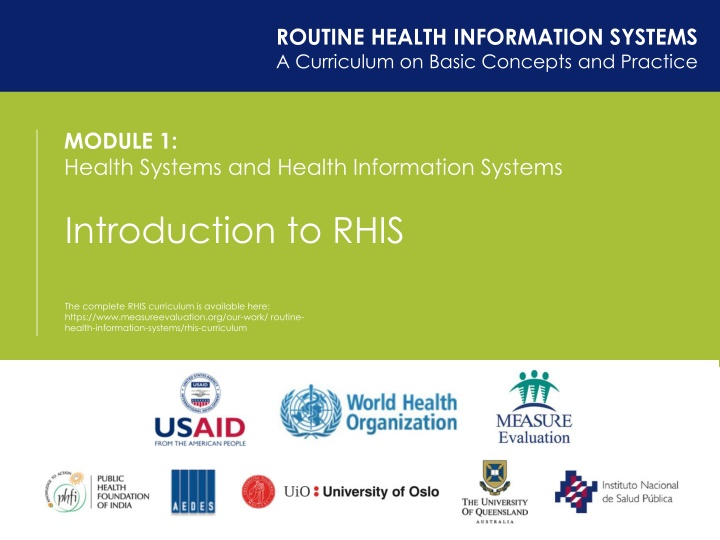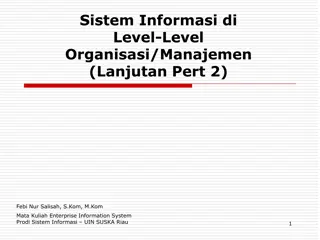
Introduction to Health Information Systems Curriculum
The Curriculum on Basic Concepts and Practice Module 1 introduces the essential link between health systems and health information systems. It covers understanding health data needs, components of an information system, data sources, RHIS definition, and more.
Download Presentation

Please find below an Image/Link to download the presentation.
The content on the website is provided AS IS for your information and personal use only. It may not be sold, licensed, or shared on other websites without obtaining consent from the author. If you encounter any issues during the download, it is possible that the publisher has removed the file from their server.
You are allowed to download the files provided on this website for personal or commercial use, subject to the condition that they are used lawfully. All files are the property of their respective owners.
The content on the website is provided AS IS for your information and personal use only. It may not be sold, licensed, or shared on other websites without obtaining consent from the author.
E N D
Presentation Transcript
ROUTINE HEALTH INFORMATION SYSTEMS A Curriculum on Basic Concepts and Practice MODULE 1: Health Systems and Health Information Systems Introduction to RHIS The complete RHIS curriculum is available here: https://www.measureevaluation.org/our-work/ routine- health-information-systems/rhis-curriculum
RHIS in the Spotlight: MA4Health Summit in June 2015 Call for Action: Maximize effective use of the data revolution, based on open standards, to rapidly improve health facility and community health information systems, including well-functioning disease and risk surveillance systems, and financial and health workforce accounts 2
Module 1 Learning Objectives By the end of this module, participants will be able to: Understand the essential link between the health system and the health information system Explain who needs health data, what type of data is needed, and how data could be used Describe the six components of a health information system, according to the Health Metrics Network (HMN) framework Describe the health data sources and give examples of each data source and its categories Define a routine health information system (RHIS) Describe what they will learn in this RHIS course 3
Module 1: Health System and Health Information System Duration: 3 hours Suggested References International Health Partnership + Related Initiatives (IPH+) and World Health Organization (WHO). (2011). Monitoring, evaluation and review of national health strategies: a country-led platform for information and accountability. Geneva, Switzerland: WHO. Retrieved from http://www.who.int/healthinfo/country_monitoring_evaluation/doc umentation/en/. Health Metrics Network. Framework and standards for country health information system, 2nd edition. (2012). Geneva, Switzerland: World Health Organization (WHO). Retrieved from http://www.hrhresourcecenter.org/node/746 WHO. Everybody s business: strengthening health systems to improve health outcomes: WHO s framework for action. (2007). Geneva: WHO. Retrieved from http://www.who.int/healthsystems/strategy/en/. WHO, United States Agency for International Development, & University of Oslo. Health facility information system resource kit. (Draft; February 2015). 4
Group Exercise on Health System Strengthening Duration: 30 minutes Read the speech given by Margaret Chan at the G8 conference in 2009 List the current health challenges Identify major themes of health system strengthening 5
The Health Challenges Based on a speech by Margaret Chan, M.D., World Health Organization (WHO) Director-General, at G8 Global Health Forum Inefficiencies in the delivery of services and good governance Access to care, especially of the poor (protect the poor; guarantee universal access to basic healthcare) Equity and fairness in health-service delivery Costs of healthcare pushing people below the poverty line Stagnancy in improving service coverage Maternal and child mortality High-mortality diseases: tuberculosis, HIV and AIDS, vaccine-preventable diseases, malaria 6
The Health Challenges Based on speech by Margaret Chan, M.D., World Health Organization (WHO) Director-General, at G8 Global Health Forum Inefficient aid: duplication, fragmentation, multiple reporting requirements, high transaction costs, and fierce competition for scarce health staff Aging population, urbanization, unhealthy lifestyles, chronic diseases brings on heavy healthcare costs Shortage of healthcare workers and specialized caregivers Financial crisis Policies, country leadership s commitment, and innovative thinking 7
Functions and Goals of a Health System (2000) GOALS/OUTCOMES OF THE SYSTEM FUNCTIONS (6 Building Blocks) Responsiveness (the way people are treated and the environment) Service delivery Quality I Human resources Coverage N P Information Health U Commodities Infrastructure T Efficiency Fairness in financial contribution S Financing Safety Stewardship Source: WHO, 2000. 8
Health System and HIS What is an information system? a system that provides specific information support to the decision-making process at each level of an organization (Hurtubise, 1984) What is a HEALTH information system? a system that provides specific information support to the decision-making process at each level of the health system 9
Health Information System Supports Decision Making at All Levels 1) At patient/client management level Management of the care of an individual patient or client using information on health status, health services, behavior and practices, and risks Management of health of family and household 10
The Health Information System Supports Decision Making at All Levels 2) At health-unit management level Monitoring and evaluation (M&E) of health services coverage and quality Management of resources for efficient and equitable allocation, distribution, and use Management of vaccines, drugs, cold chain Planning program interventions; annual planning Disease surveillance 11
The Health Information System Supports Decision Making at All Levels 3) At system management level (district/regional/national) Policy and strategy decisions Health programs planning and management Resource management Capacity building Disease surveillance Innovations Research and M&E 12
Small-Group Exercise on Information Needs Duration: 30 minutes Identify information needs in support of management functions at all levels Use matrix of next slide 13
Management Functions and Information Support Management Level Functions Information Needs Patient/client Health unit Health system 14
Management Functions and Information Support Management Level Functions Information Need Patient/client Provide quality care Provide continuity of care Diagnostic information Past history Family history Health unit Provide pregnancy care to all pregnant women in catchment area Service coverage Geographic pockets of underserved women Commodity supply data Health system Ensure distribution of health commodities in the district Number of stockouts for essential drugs or vaccines Drug cost and efficacy 15
Sources of Health Information Population-based data sources Census Surveys Civil registration 16
Sources of Health Information Institution-based sources Hospitals, health centers, community-based institutions/service delivery mechanisms Generate data as a result of administrative and operational activities from: Individual records Service records Resource records Health facility surveys 17
Components and Standards of a National Health Information System (HMN, 2008) 18
Definition of a Routine Health Information System A routine health information system produces information through routine data collection (periods of less than a year) Data are collected by care providers in communities, in primary care facilities, in hospitals, and by routine health-facility assessment (through supervision of surveys) 19
The Universe of Routine Health Information Systems (Also Known as Institution-based Information Systems) Individualrecord systems (facility- and community-based) Paper-based records Electronic medical records (EMR) Service record systems Health management information systems (HMIS) Facility- and community-based Public, private, and parastatal Laboratory and imaging information systems (LIIS) Disease surveillance information systems 20
The Universe of Routine Health Information Systems (Also Known as Institution-based Information Systems) Resource record systems Financial management information systems (FMIS) Human resource information systems (HRIS) Logistics management information systems (LMIS) Infrastructure and equipment management information systems (IEMIS) Health facility surveys Service availability and readiness Quality of care Supervisory records 21
The Role and Importance of Decentralized Routine Health Information Systems Main source of information for (daily) planning and management of quality health services at district level and below Coverage and quality of health interventions Disease surveillance Commodity security Financial information systems Also feeding real-time information to national and global levels Ideal information system in support of integrated management of health interventions 22
Performance Criteria of a Well-Functioning Routine Health Information System Governance and management Policies, legislation, plans, accountability, and operational procedures Data standards and accountability Human resources ICT infrastructure Data quality Individual client data Aggregate facility data Aggregate community data Assessment of data quality Assurance of data quality Information Use Relevant Indicators Data analysis Data visualization Data interoperability Problem solving 23
Routine Health Information System Course Purpose of This Course Participants will acquire basic knowledge of RHIS core competencies to conceptualize, design, develop, govern, and manage RHIS. They will use the information the RHIS generates to improve public health practices and service delivery. 24
Routine Health Information System Course Target Audience Health workforce oPolicymakers oManagers oCare providers oTechnicians Students 25
Course Modules INTRODUCTION 1. Health Systems and Health Information Systems RHIS DATA GENERATION 2. Indicators and Data Collection and Reporting 3. Data Management Standards for Routine Health Information Systems 4. RHIS Data Quality 5. RHIS Data Analysis 6. RHIS Data Demand and Use 26
Course Modules RHIS MANAGEMENT 7. RHIS Governance and Management of Resources 8. Information and Communication Technology for RHIS RHIS STRENGTHENING AND REFORM 9. RHIS Performance Assessment 10. RHIS Design and Reform 27
ROUTINE HEALTH INFORMATION SYSTEMS A Curriculum on Basic Concepts and Practice This presentation was produced with the support of the United States Agency for International Development (USAID) under the terms of MEASURE Evaluation cooperative agreement AID-OAA-L-14-00004. MEASURE Evaluation is implemented by the Carolina Population Center, University of North Carolina at Chapel Hill in partnership with ICF International; John Snow, Inc.; Management Sciences for Health; Palladium; and Tulane University. The views expressed in this presentation do not necessarily reflect the views of USAID or the United States government.






















